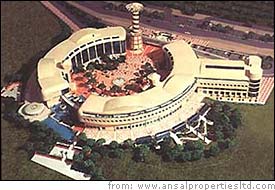NEW YORK (CNN/Money) -
Indian workers have been getting U.S. jobs. Now U.S. retailers want to get their money.
"Because of India's status as a good IT hub for outsourcing by U.S. companies, young Indians between 20 to 24 years old, who ordinarily wouldn't be able to find work easily, are finding jobs with call centers straight out of college. This is a consumer base that typically lives at home, with the family. Now they have disposable income that's totally discretionary and about 20 to 30 percent higher than prevailing wages," said Manisha Juneja, analyst with Indian retail consultancy KPA-Techpak.
"What are they spending it on? Food, books, music, cell phones and brand-name clothes. Who's taking note of this? Companies like Tommy Hilfiger," Juneja said.
India's $200 billion retail market is still small compared to other growing overseas markets. But it is expected to boom in the next few years.
 |
|
| The Ansal Plaza shopping mall in New Delhi features a McDonalds and a department store with retail outlets selling Nike, Reebok, Burberry's and Gucci brand products. |
"India appears to be taking off, having become the location of choice for many outsourced processes that involve knowledge of English and /or skills with information technology," according to a 2004 market study by consulting firm Deloitte Research.
"Although this nation of one billion people has a per capita income only half that of China, it's estimated that there are roughly 150 million middle class consumers. For retailers, these facts present a great opportunity," the report said.
And that growth is tempting U.S. retailers, despite serious trade barriers, to test the waters. Some are setting up shop there in a limited way. Others, notably retailing behemoth Wal-Mart, are establishing sourcing centers and cautiously learning about the local market first.
"Sportswear companies Nike and Reebok. Hugo Boss opened two stores last year," said Michael Fernandes, retail consultant with McKinsey & Co. in New Delhi. Separately, U.K.-based department store Marks and Spencer, clothing retailer Benetton, and more recently Spanish clothing chain Mango have also broken ground in India.
"Two interesting things are happening. The growth of western-style malls is changing the way urban consumers shop," said Fernandes. "Secondly, we're seeing many more big box, value-based formats setting up shop. The size of these stores is about 50,000 square feet, a departure from the smaller mom & pop-type store that dominates the local retail landscape," he said.
Apparel retailer Tommy Hilfiger is reportedly the latest entrant into India. According to trade publication Women's Wear Daily, the company is expected to open at least six free-standing Tommy Hilfiger stores in major cities, carrying men's and junior sportswear and jeanswear. Tommy Hilfiger did not return calls for comment.
Wal-Mart interested, but cautious
Wal-Mart CEO Lee Scott, in a speech to the National Retail Federation's annual convention this past January, said his company is eyeing India as well...especially in light of indications that the Indian government may be gearing up to relax excessive regulations that have hampered retail growth in the past.
''I think we will see global retailers moving to India over the next few years to take advantage of what is happening there,'' Scott said.
Current norms regulating foreign direct investment don't allow global retailers to invest directly in India. So the way global retailers enter the market is either through joint ventures, as Hilfiger did, or through franchisee operations or cash-and-carry formats.
"The next stage of economic reforms would be to allow a 100 percent equity-owned policy," said Dr. Amit Mitra, secretary general of the Federation of Indian Chambers of Commerce & Industry (FICCI). Mitra wouldn't specify the time frame but indicated that a policy change might take effect as early as this summer.
According to Bill Wertz, Wal-Mart's director of International marketing affairs, Wal-Mart currently is trying to expand its supplier sourcing in India.
| Related stories:
|

|
|
|
|
"We are interested in importing more from India. Opening stores there is more complicated, primarily because of the regulation issues," said Wertz. "Down the road we may be interested in building stores there. The most encouraging factor for us is the size of the market."
McKinsey's Michael Fernandes thinks the market size could grow to over $500 billion in the next 5 to 6 years. Nevertheless, he agreed that India has a long way to go to catch up with the popularity of its Asian rivals China, Malaysia and Thailand.
"India is among the top 15 global retail markets but it's also perhaps among the least actively competed for with global retailers," said Fernandes. "Gaining entry is the first hurdle, attractive real estate in big cities is hard to find, and its a logistically fragmented country with a complicated tax structure. But transformation is happening and it's possible to overcome some of these issues."
But the time frame is not immediate.
"Besides the political issues, retailers interested in India have to understand the cultural differences and sensitivities," said Conference Board economist Delos Smith. "Ultimately India's still a very complicated world for Western companies to understand."

|

